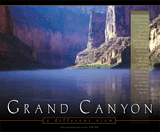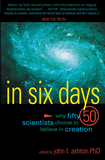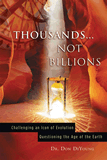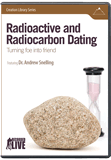
Radiometric Dating: Problems with the Assumptions
Radiometric dating is often used to “prove” rocks are millions of years old. Once you understand the basic science, however, you can see how wrong assumptions lead to incorrect dates.
Radiometric Dating 101
PART 2: Problems with the Assumptions
PART 3: Making Sense of the Patterns
This three-part series will help you properly understand radiometric dating, the assumptions that lead to inaccurate dates, and the clues about what really happened in the past.
Most people think that radioactive dating has proven the earth is billions of years old. Yet this view is based on a misunderstanding of how radiometric dating works. Part 1 (in the previous issue) explained how scientists observe unstable atoms changing into stable atoms in the present. Part 2 explains how scientists run into problems when they make assumptions about what happened in the unobserved past.
The Hourglass “Clock”—An Analogy for Dating Rocks
An hourglass is a helpful analogy to explain how geologists calculate the ages of rocks. When we look at sand in an hourglass, we can estimate how much time has passed based on the amount of sand that has fallen to the bottom.
The reliability of radiometric dating is subject to three unprovable assumptions that every geologist must make when using the radioactive “clock”.
Radioactive rocks offer a similar “clock.” Radioactive atoms, such as uranium (the parent isotopes), decay into stable atoms, such as lead (the daughter isotopes), at a measurable rate. To date a radioactive rock, geologists first measure the “sand grains” in the top glass bowl (the parent radioisotope, such as uranium-238 or potassium-40).
They also measure the sand grains in the bottom bowl (the daughter isotope, such as lead-206 or argon-40, respectively). Based on these observations and the known rate of radioactive decay, they estimate the time it has taken for the daughter isotope to accumulate in the rock.
However, unlike the hourglass whose accuracy can be tested by turning it upside down and comparing it to trustworthy clocks, the reliability of the radioactive “clock” is subject to three unprovable assumptions. No geologist was present when the rocks were formed to see their contents, and no geologist was present to measure how fast the radioactive “clock” has been running through the millions of years that supposedly passed after the rock was formed.
Assumption 1: Conditions at Time Zero
No geologists were present when most rocks formed, so they cannot test whether the original rocks already contained daughter isotopes alongside their parent radioisotopes. For example, with regard to the volcanic lavas that erupted, flowed, and cooled to form rocks in the unobserved past, evolutionary geologists simply assume that none of the daughter argon-40 atoms was in the lava rocks.
For the other radioactive “clocks,” it is assumed that by analyzing multiple samples of a rock body, or unit, today it is possible to determine how much of the daughter isotopes (lead, strontium, or neodymium) were present when the rock formed (via the so-called isochron technique, which is still based on unproven assumptions 2 and 3).
Yet lava flows that have occurred in the present have been tested soon after they erupted, and they invariably contained much more argon-40 than expected.1 For example, when a sample of the lava in the Mt. St. Helens crater (that had been observed to form and cool in 1986) (Figure 1) was analyzed in 1996, it contained so much argon-40 that it had a calculated “age” of 350,000 years!2 Similarly, lava flows on the sides of Mt. Ngauruhoe, New Zealand (Figure 2), known to be less than 50 years old, yielded “ages” of up to 3.5 million years.3

Click here to view larger picture (PDF format).
So it is logical to conclude that if recent lava flows of known age yield incorrect old potassium-argon ages due to the extra argon-40 that they inherited from the erupting volcanoes, then ancient lava flows of unknown ages could likewise have inherited extra argon-40 and yield excessively old ages.
There are similar problems with the other radioactive “clocks.” For example, consider the dating of Grand Canyon’s basalts (rocks formed by lava cooling at the earth’s surface). We find places on the North Rim where volcanoes erupted after the Canyon was formed, sending lavas cascading over the walls and down into the Canyon.
Obviously, these eruptions took place very recently, after the Canyon’s layers were deposited (Figure 3). These basalts yield ages of up to 1 million years based on the amounts of potassium and argon isotopes in the rocks. But when we date the rocks using the rubidium and strontium isotopes, we get an age of 1.143 billion years. This is the same age that we get for the basalt layers deep below the walls of the eastern Grand Canyon.4
How could both lavas—one at the top and one at the bottom of the Canyon—be the same age based on these parent and daughter isotopes? One solution is that both the recent and early lava flows inherited the same rubidium-strontium chemistry—not age—from the same source, deep in the earth’s upper mantle. This source already had both rubidium and strontium.
To make matters even worse for the claimed reliability of these radiometric dating methods, these same basalts that flowed from the top of the Canyon yield a samarium-neodymium age of about 916 million years,5 and a uranium-lead age of about 2.6 billion years!6
Assumption 2: No Contamination
The problems with contamination, as with inheritance, are already well-documented in the textbooks on radioactive dating of rocks.7 Unlike the hourglass, where its two bowls are sealed, the radioactive “clock” in rocks is open to contamination by gain or loss of parent or daughter isotopes because of waters flowing in the ground from rainfall and from the molten rocks beneath volcanoes. Similarly, as molten lava rises through a conduit from deep inside the earth to be erupted through a volcano, pieces of the conduit wallrocks and their isotopes can mix into the lava and contaminate it.
Because of such contamination, the less than 50-year-old lava flows at Mt. Ngauruhoe, New Zealand (Figure 4), yield a rubidium-strontium “age” of 133 million years, a samarium-neodymium “age” of 197 million years, and a uranium-lead “age” of 3.908 billion years!8
Assumption 3: Constant Decay Rate
Physicists have carefully measured the radioactive decay rates of parent radioisotopes in laboratories over the last 100 or so years and have found them to be essentially constant (within the measurement error margins). Furthermore, they have not been able to significantly change these decay rates by heat, pressure, or electrical and magnetic fields. So geologists have assumed these radioactive decay rates have been constant for billions of years.
However, this is an enormous extrapolation of seven orders of magnitude back through immense spans of unobserved time without any concrete proof that such an extrapolation is credible. Nevertheless, geologists insist the radioactive decay rates have always been constant, because it makes these radioactive clocks “work”!
New evidence, however, has recently been discovered that can only be explained by the radioactive decay rates not having been constant in the past.9 For example, the radioactive decay of uranium in tiny crystals in a New Mexico granite (Figure 5) yields a uranium-lead “age” of 1.5 billion years. Yet the same uranium decay also produced abundant helium, but only 6,000 years worth of that helium was found to have leaked out of the tiny crystals.
This means that the uranium must have decayed very rapidly over the same 6,000 years that the helium was leaking. The rate of uranium decay must have been at least 250,000 times faster than today’s measured rate! For more details see Don DeYoung’s Thousands . . . Not Billions (Master Books, Green Forest, Arkansas, 2005), pages 65–78.
If these clocks are based on faulty assumptions and yield unreliable results, then scientists should not trust or promote the claimed radioactive “ages.”
The assumptions on which the radioactive dating is based are not only unprovable but plagued with problems. As this article has illustrated, rocks may have inherited parent and daughter isotopes from their sources, or they may have been contaminated when they moved through other rocks to their current locations. Or inflowing water may have mixed isotopes into the rocks. In addition, the radioactive decay rates have not been constant.
So if these clocks are based on faulty assumptions and yield unreliable results, then scientists should not trust or promote the claimed radioactive “ages” of countless millions of years, especially since they contradict the true history of the universe as recorded in God’s Word.
Answers Magazine
October – December 2009
When it comes to God’s marvelous creation, nothing compares to the amazing design of the human body. From the protective garment of skin to the engineering of our bones and new discoveries about our brain, this issue is packed with testimony to the Master Designer.
Browse Issue SubscribeFootnotes
- A. A. Snelling, “Geochemical Processes in the Mantle and Crust,” in Radioisotopes and the Age of the Earth: A Young-Earth Creationist Research Initiative, L. Vardiman, A. A. Snelling, and E. F. Chaffin, eds. (El Cajon, California: Institute for Creation Research; St. Joseph, Missouri: Creation Research Society, 2000), pp. 123–304.
- S. A. Austin, “Excess Argon within Mineral Concentrates from the New Dacite Lava Dome at Mount St. Helens Volcano,” Creation Ex Nihilo Technical Journal 10.3 (1996): 335–343.
- A. A. Snelling, “The Cause of Anomalous Potassium-Argon ‘Ages’ for Recent Andesite Flows at Mt. Ngauruhoe, New Zealand, and the Implications for Potassium-Argon ‘Dating,’” in Proceedings of the Fourth International Conference on Creationism, ed. R. E. Walsh (Pittsburgh: Creation Science Fellowship, 1998), pp. 503–525.
- A. A. Snelling, “Isochron Discordances and the Role of Inheritance and Mixing of Radioisotopes in the Mantle and Crust,” in Radioisotopes and the Age of the Earth: Results of a Young-Earth Creationist Research Initiative, eds. L. Vardiman, A. A. Snelling, and E. F. Chaffin (El Cajon, California: Institute for Creation Research; Chino Valley, Arizona: Creation Research Society, 2005), pp. 393–524; D. B. DeYoung, “Radioisotope Dating Case Studies” in Thousands . . . Not Billions (Green Forest, Arkansas: Master Books, 2005), pp. 123–139.
- Ref. 4, 2005.
- S. A. Austin, ed., Grand Canyon: Monument to Catastrophe (Santee, California: Institute for Creation Research, 1994), pp. 123–126.
- G. Faure and T. M. Mensing, Isotopes: Principles and Applications, 3rd ed. (Hoboken, New Jersey: John Wiley & Sons, Hoboken, 2005); A. P. Dickin, Radiogenic Isotope Geology, 2nd ed. (UK: Cambridge University Press, 2005).
- A. A. Snelling, “The Relevance of Rb-Sr, Sm-Nd and Pb-Pb Isotope Systematics to Elucidation of the Genesis and History of Recent Andesite Flows at Mt. Ngauruhoe, New Zealand, and the Implications for Radioisotopic Dating,” in Proceedings of the Fifth International Conference on Creationism, ed. R. L. Ivey, Jr. (Pittsburgh: Creation Science Fellowship, 2003), pp. 285–303; Ref. 4, 2005.
- L. Vardiman, A. A. Snelling, and E. F. Chaffin, eds., Radioisotopes and the Age of the Earth: Results of a Young-Earth Creationist Research Initiative (El Cajon, California: Institute for Creation Research; Chino Valley, Arizona: Creation Research Society, 2005); D. B. DeYoung, Thousands . . . Not Billions (Green Forest, Arkansas: Master Books, 2005).
Recommended Resources

Answers in Genesis is an apologetics ministry, dedicated to helping Christians defend their faith and proclaim the good news of Jesus Christ.
- Customer Service 800.778.3390
- © 2024 Answers in Genesis









